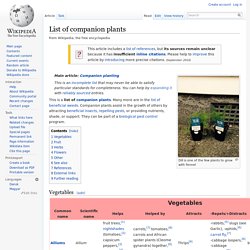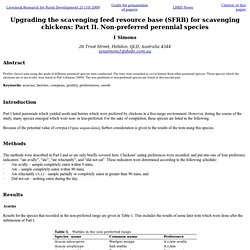

Lost Crops of the Incas: Little-Known Plants of the Andes with Promise for Worldwide Cultivation. About 3,000 years ago, an ingenious form of agriculture was devised on the high plains of the Peruvian Andes.

It employed platforms of soil surrounded by ditches filled with water. For centuries this method flourished because it produced bumper crops in the face of floods, droughts, and the killing frosts of those 3,800-m altitudes. Around Lake Titicaca, remnants of over 80,000 hectares of these raised fields (waru waru) can still be found. Many date back at least 2,000 years. Now, in a dramatic resurrection, modern-day Peruvians working with archeologists have reconstructed some of the ancient arms, and the results have been amazing. The combination of raised beds and canals has proved to have remarkably sophisticated environmental effects. . ~ enlarge ~ Recherche documentaire sur l'utilisation de cultures-abris dans le cadre de systèmes de lutte intégrée contre les mauvaises herbes dans les cultures de légumes de plein champ au Canada - Programme de réduction des risques liés aux pesticides.
Chef de Projet Bonnie Ball Coelho - Agriculture et Agroalimentaire Canada.

Rotable.pdf. List of companion plants. Dill is one of the few plants to grow with Fennel This is a list of companion plants.

Many more are in the list of beneficial weeds. Companion plants assist in the growth of others by attracting beneficial insects, repelling pests, or providing nutrients, shade, or support. They can be part of a biological pest control program. Vegetables[edit] Fruit[edit] Herbs[edit] Flowers[edit] Other[edit] See also[edit] References[edit] External links[edit] Associations-de-cultures.pdf (Objet application/pdf) [permaculture] perennial tuberous Three Sisters alterna-guild? Neshura neshura at gmail.com Tue May 2 11:23:19 EDT 2006 Hello all!
![[permaculture] perennial tuberous Three Sisters alterna-guild?](http://cdn.pearltrees.com/s/pic/th/permaculture-perennial-38329392)
Just thought I would run this by you; I purchased some jerusalem artichoke and groundnut and planted them up together in a very large self-watering container, for lack of another location. I planted them together because it occurred to me that the groundnut, being a vining sort, might enjoy growing up into eight or ten feet worth of jerusalem artichokes. This morning, after weeks of failing to notice the similarity between this arrangement and the native american corn-beans-squash arrangement that's mentioned everywhere from my fifth grade Social Studies book to most of my permaculture texts....it occurred to me that perhaps there was a similarity and that a third low-growing component could be added.
Crop Rotations for Increased Productivity. A list of current publications from NDSU Extension Service.

The materials on this site are organized by topic. Use the menu to browse for materials related to the listed topics. You'll find the most recent materials at the top of each list. The educational materials listed here have been through a thorough review process and are available in hard copy from the Distribution Center unless marked otherwise. Most are free in PDF format. Fast-growing crop - Pesquisa do Google. Case Study: The Baranaja System. People in Conservation Volume 2 Issue 1, January 2009 Jardhargaon is a village at a height of 1500 metres situated in the hilly district of Tehri Garhwal in the State of Uttarakhand in North India.

Jardhargaon has pine forests, village grasslands (Civil Soyam Forest) and dense Reserved Forests covering an area of 429.5 ha consisting primarily of oak and rhododendron trees. Cultivation is the main livelihood of the people of this region. This is part of the Garhwal region where the Chipko Movement took place. The Chipko Movement started in the early 1980s as a spontaneous local protest against tree felling by contractors and it spread rapidly across the region. Since returning home from the Movement, Jardhari has been instrumental in ushering in a conservation movement of a quieter and deeper kind in his Village. Another movement called the Beej Bachao Andolan (Save the Seeds Movement) started a few years after the forest protection activity. Beej Bachao Andolan. Daikon - PermaWiki. Upgrading the scavenging feed resource base (SFRB) for scavenging chickens: Part II. Non-preferred perennial species.
26 Trost Street, Helidon, QLD, Australia 4344iansimons1@dodo.com.au Abstract Poultry choice tests using the seeds of different perennial species were conducted.

The tests were extended to cover berries from other perennial species. Those species which the chickens ate or ate avidly were listed in Part I (Simons 2009). The non-preferred or less-preferred species are listed in this second part. Keywords: acacias, berries, cowpeas, poultry, preferences, seeds Introduction Part I listed perennials which yielded seeds and berries which were preferred by chickens in a free-range environment. Because of the potential value of cowpea (Vigna unguiculata), further consideration is given to the results of the tests using this species. Methods The methods were described in Part I and so are only briefly covered here. . · Ate avidly – sample completely eaten within 9 mins, · Ate – sample completely eaten within 90 mins, · Did not eat – nothing eaten during the day. Results Acacias. List of Vegetables - PermaWiki. Sod Seeding Techniques.
In briefAdequate soil fertility is necessary for successful forage establishment.

Seed early to take advantage of existing soil moisture. Accurate seed placement is critical to the success of any forage crop. Good seed/soil contact is critical to germination. Minimize competition from surrounding vegetation. Sod seeding is only one part of a sound pasture management program. Ley Farming - Chapter 9.